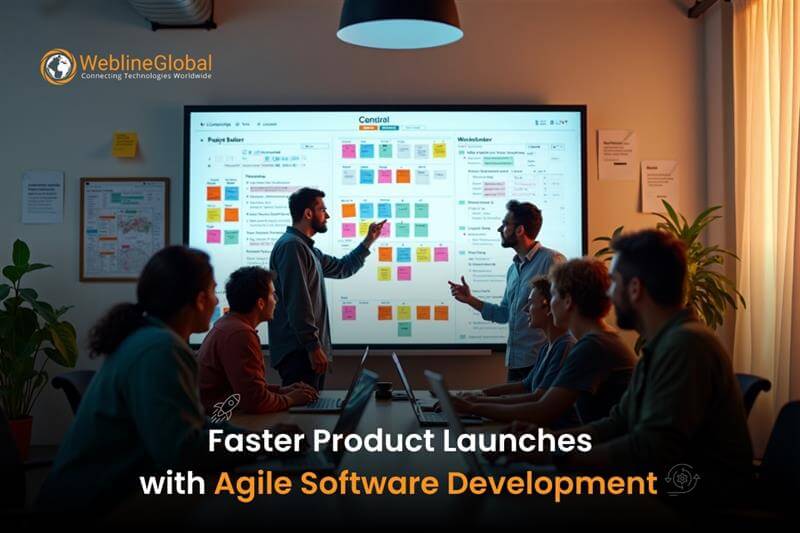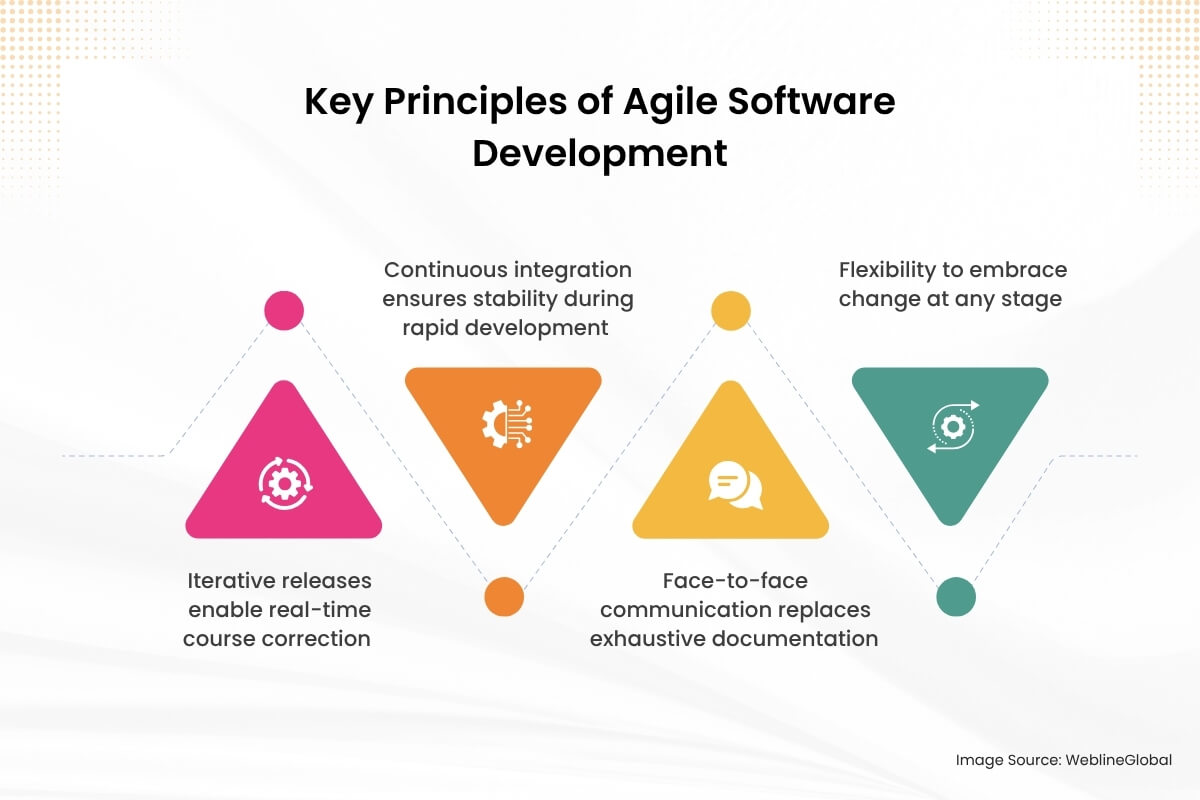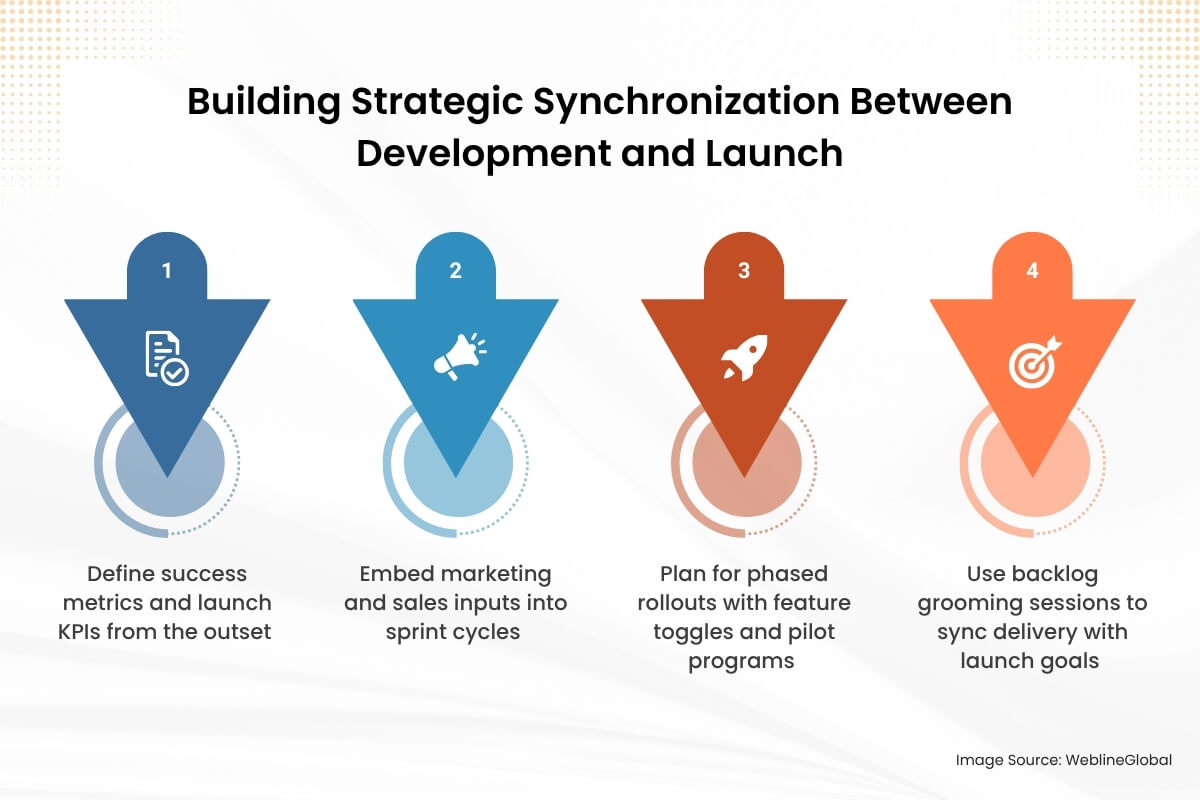
In any modern-day business, speed is often the deciding factor in the success or failure of a product. To achieve rapid iterations, adaptive planning, and swift product releases, businesses are increasingly turning to agile software development practices. Agile engineering has transformed how companies approach new product initiatives, helping them streamline processes, reduce risk, and deliver high-quality solutions at speed.
Whether it’s launching a brand-new product or modernizing an existing platform, agile product development provides the structure and flexibility required to meet evolving demands.
Let us delve into how adopting an agile product development mindset accelerates time-to-market and enhances product quality, especially when coupled with a robust product launch strategy and collaborative agile software teams.
Want to launch faster with fewer risks? Talk to our agile software experts today.
Understanding the Core of Agile Software Development
Agile software development represents a structured yet highly flexible approach to building software in incremental phases. It emphasizes iterative progress, continuous feedback, and adaptability to change, which contrasts sharply with the rigidity of traditional waterfall models. This methodology aligns closely with modern business needs, especially for teams focused on fast delivery and responsiveness to customer input.
Key Principles of Agile Software Development
The strength of agile software development lies in its ability to deliver working software frequently while welcoming changing requirements at any stage of development. Agile’s guiding principles aim to maximize collaboration and quality through focused iteration cycles.

Iterative releases enable real-time course correction
Instead of waiting months for a final product, development is broken into short iterations (sprints), usually two to four weeks long. Each iteration results in a usable piece of software, allowing stakeholders to test and provide feedback early in the cycle, improving alignment with expectations.
Continuous integration ensures stability during rapid development
Teams use automation tools to integrate code changes regularly, which helps identify issues quickly. This approach keeps the codebase stable and ready for deployment, ensuring that software quality isn’t sacrificed for speed.
Face-to-face communication replaces exhaustive documentation
Agile places high value on direct interactions. Regular stand-ups, sprint planning, and reviews enhance clarity and remove misunderstandings that often arise from static documents, especially in fast-moving projects.
Flexibility to embrace change at any stage
Requirements often evolve during a project. Agile’s structure is designed to absorb these changes without disrupting the workflow. Product owners can reprioritize backlogs or insert new features into upcoming sprints based on business or user input.
How Agile Engineering Accelerates Product Launches
Agile engineering introduces discipline and structure into the flexible nature of agile software development. While agility emphasizes iteration and adaptability, agile engineering ensures technical robustness through practices like continuous integration, automated testing, and scalable architecture design. This combination significantly improves time-to-market without compromising product reliability or performance.
Technical Practices Embedded in Agile Engineering
To enable rapid releases without sacrificing quality, agile engineering integrates a set of proven technical practices directly into the development workflow. These are essential for companies aiming to build production-ready software quickly and efficiently.
Test-Driven Development (TDD) builds confidence in every release
Developers write unit tests before coding begins, ensuring that each component behaves as intended from the outset. TDD reduces bugs and simplifies maintenance, which is crucial when timelines are tight and frequent releases are planned.
CI/CD pipelines automate build, test, and deployment cycles
Continuous Integration (CI) merges code into a shared repository multiple times a day, while Continuous Deployment (CD) ensures that tested builds are automatically delivered to staging or production environments. This tightens feedback loops and supports faster rollouts.
Microservices architecture enables independent development streams
Instead of building one monolithic application, agile software teams often use microservices—modular components that can be developed, tested, and deployed independently. This architecture reduces bottlenecks and allows multiple features to be worked on in parallel.
DevOps practices bridge development and operations seamlessly
Agile engineering integrates DevOps practices to streamline software delivery, reduce friction between teams, and create automated workflows. Infrastructure as Code (IaC), monitoring, and automated rollback mechanisms are common tools used to sustain speed without introducing risk.
Need help implementing Agile & DevOps? Get end-to-end support from WeblineGlobal now.
Aligning Agile Product Development with Product Goals
Agile product development is not just a method for writing code—it’s a strategic framework that ensures product features directly support user needs and business objectives. It aligns product vision with iterative execution, allowing organizations to test ideas early, respond to user feedback, and continuously refine priorities throughout the development lifecycle.
Strategic Benefits of Agile Product Development
The iterative nature of agile product development empowers teams to validate assumptions quickly, adjust features based on user data, and incrementally deliver customer value. This alignment between execution and goals is crucial in competitive markets where rapid iteration can determine success.
- Minimum Viable Products (MVPs) enable fast validation of core ideas: Building an MVP allows teams to test their most critical assumptions with minimal resources. Feedback collected from early adopters helps refine the product direction, which saves time and cost in later development cycles.
- Data-driven decision-making optimizes backlog priorities: Using analytics and user behavior insights, product owners can decide which features should be built, enhanced, or removed. This helps agile software teams avoid overengineering and focus on functionalities that directly impact KPIs.
- Cross-functional collaboration improves speed and alignment: In agile product development, designers, developers, and product managers work together during every sprint. This eliminates silos, reduces delays in decision-making, and ensures that each feature is shaped by technical feasibility and user needs.
- Iterative planning ensures goals evolve with market changes: Agile planning is not a one-time event but a continuous process. Sprint reviews and retrospectives create opportunities to adjust product direction based on stakeholder input or competitive shifts, ensuring long-term relevance.
The Role of Agile Software Teams in Fast Delivery
Well-structured agile software teams are at the heart of any successful agile software development initiative. These teams are cross-functional, self-managing, and deeply collaborative capable of owning the entire product delivery lifecycle. Their composition and workflow enable quick iterations, transparent communication, and frequent delivery of high-quality features, making them instrumental in accelerating time-to-market.
Characteristics of High-Performing Agile Software Teams
Effective agile software teams are designed for adaptability and output. Their operational practices and culture foster clarity, responsibility, and consistent delivery. Each team member contributes to planning, coding, testing, and reviewing, which reduces dependency bottlenecks and increases efficiency.
Daily stand-ups maintain alignment and focus
Every team member shares progress, challenges, and immediate plans in a short daily meeting. This routine keeps everyone informed, uncovers blockers early, and fosters a shared understanding of project status, ensuring alignment without delays.
Sprint reviews create shared accountability and learning
At the end of each sprint, teams demonstrate what they’ve built to stakeholders. This regular feedback cycle promotes accountability, confirms feature expectations, and provides insights for future development decisions, reinforcing continuous improvement.
Retrospectives turn experience into actionable improvements
After every sprint, teams discuss what went well, what didn’t, and what can be improved. Retrospectives build a learning culture where process enhancements, communication gaps, and tooling improvements are actively discussed and implemented.
Code reviews and pair programming improve quality and cohesion
Writing code is not a solo activity in agile software teams. Pair programming promotes shared knowledge and reduces onboarding time for new members, while code reviews ensure adherence to quality standards and project-wide consistency.
Integrating Product Launch Strategy into Agile Execution
A strong product launch strategy doesn’t begin at the final development phase—it’s tightly integrated with each sprint and planning activity. In agile software development, aligning release planning, marketing coordination, and stakeholder engagement throughout the project lifecycle allows for faster and more impactful product launches. The strategy evolves alongside the product, ensuring that timing, messaging, and feature readiness are perfectly in sync.
Building Strategic Synchronization Between Development and Launch
When agile product development is connected to a well-defined product launch strategy, teams can ensure technical readiness and market readiness progress together. Planning the go-to-market (GTM) approach early helps avoid last-minute blockers, misalignment, or suboptimal launch timing.

Define success metrics and launch KPIs from the outset
Metrics like adoption rate, user engagement, and feature usage should be established during early sprint planning. These guide decision-making during development and shape what gets prioritized, ensuring alignment between the engineering and marketing goals.
Embed marketing and sales inputs into sprint cycles
Involving GTM stakeholders early gives agile software teams visibility into customer expectations, competitive positioning, and messaging plans. This ensures that technical capabilities align with promotional commitments, helping the product reach the market as planned.
Plan for phased rollouts with feature toggles and pilot programs
Rather than releasing all features at once, agile engineering supports staged deployments. Feature toggles allow teams to activate or deactivate functionalities post-deployment, while pilot programs with selected users provide a controlled environment to test scalability and usability.
Use backlog grooming sessions to sync delivery with launch goals
Regular backlog reviews are used not just to refine technical work but to coordinate around launch activities. Marketing materials, documentation, and demo content are scheduled into sprints, ensuring readiness beyond just code deployment.
Greenfield vs. Brownfield in the Agile Context
Both greenfield software development and brownfield software development play critical roles in modern product strategy. Each requires tailored planning, resource allocation, and risk management.
Integrating the above-mentioned development types into agile software development allows organizations to remain responsive and focused, whether they’re building entirely new systems or enhancing existing ones. Choosing the right agile engineering tactics for each is essential to achieving accelerated product delivery.
What Is Greenfield Software Development?
Greenfield software development refers to projects that start from a clean slate, with no legacy code, systems, or architecture. These initiatives allow agile software teams to choose modern tools, frameworks, and architectural models, supporting innovation and rapid prototyping.
Freedom to architect solutions with the latest technologies
Since no legacy constraints exist, teams can select optimal technologies for performance, scalability, and maintainability. This often includes adopting microservices, event-driven systems, or serverless infrastructure, which aligns perfectly with agile’s iterative build philosophy.
Enables rapid MVP delivery and course correction
Agile methodologies fit naturally in greenfield software development as features can be released in small, testable increments. Early versions of the product are shared with users, and real-world feedback is used to shape the roadmap with minimal refactoring effort.
Supports AI and ML experimentation from the ground up
Greenfield software development also opens the door for integrating AI agents or ML capabilities early in the design. For instance, intelligent recommendations, predictive analytics, or agent-driven automation can be embedded as native features rather than retrofits.
What Is Brownfield Software Development?
Brownfield software development involves modifying or expanding existing systems. These projects are common in enterprises where legacy platforms still handle mission-critical operations. Agile execution in these scenarios demands strong collaboration, clear dependencies, and disciplined testing.
Requires thorough analysis of existing systems and dependencies
Before changes are made, agile software teams perform deep technical analysis to identify risks and integration points. This step is vital to avoid regressions, unexpected behavior, or compatibility issues with surrounding systems.
Agile planning must account for legacy constraints and integration
Sprints often include both new development and modernization tasks, such as refactoring code, replacing APIs, or cleaning up technical debt. These tasks are carefully estimated and prioritized to deliver value without destabilizing core functionality.
Testing and deployment pipelines are tailored for mixed environments
CI/CD workflows in brownfield software development need to accommodate multiple environments and legacy components. Regression tests, automated rollback strategies, and change management processes ensure reliability while supporting incremental updates.
When AI and ML Solutions Make Sense
In specific cases, AI and ML solutions can dramatically speed up product development and optimize feature relevance. For instance, you can hire AI developers to build agents that can automate routine testing, bug tracking, or even customer support. Although not necessary for all projects, integrating AI and ML solutions where suitable enhances innovation and responsiveness.
In agile product development, incorporating ML algorithms for personalization or predictive analysis can offer strategic advantages.
Examples include:
- Using an AI agent to predict sprint delays based on past team performance
- Employing ML for sentiment analysis during product feedback collection
- Implementing an agentic solution to manage dynamic pricing in e-commerce platforms
Real-World Acceleration: Agile in Action
To demonstrate the impact of agile engineering, consider a SaaS company preparing for a major product overhaul. This ability to roll out, measure, and iterate while maintaining product stability is the hallmark of successful agile software teams.
Using agile software development methodologies:
- The team launched a pilot MVP in 6 weeks
- User feedback was implemented in the next two sprints
- A coordinated product launch strategy aligned with PR and marketing milestones
- Feature releases continued post-launch through continuous deployment
Why WeblineGlobal Is Your Partner in Accelerated Agile Launches
Choosing the right partner for your software journey is crucial. WeblineGlobal brings years of expertise in agile software development in the US, helping clients move from concept to deployment with efficiency and confidence.
Our team excels in:
- Building high-functioning agile software teams tailored to your needs
- Implementing structured yet flexible agile engineering frameworks
- Crafting intelligent product launch strategy plans that sync with dev cycles
- Navigating both greenfield software development and brownfield software development projects with strategic planning
Whether your goal is to develop a new AI solution or modernize an existing platform, WeblineGlobal software company in the USA ensures your product reaches the market faster, with the right features and the right impact.
Social Hashtags
#AgileDevelopment #AgileSoftwareDevelopment #ProductLaunch #SoftwareEngineering #DevOps #AgileTeams #MVPStrategy #TimeToMarket #CICD #TechInnovation #WeblineGlobal
Ready to turn your idea into a product? Let’s build your agile roadmap together.




